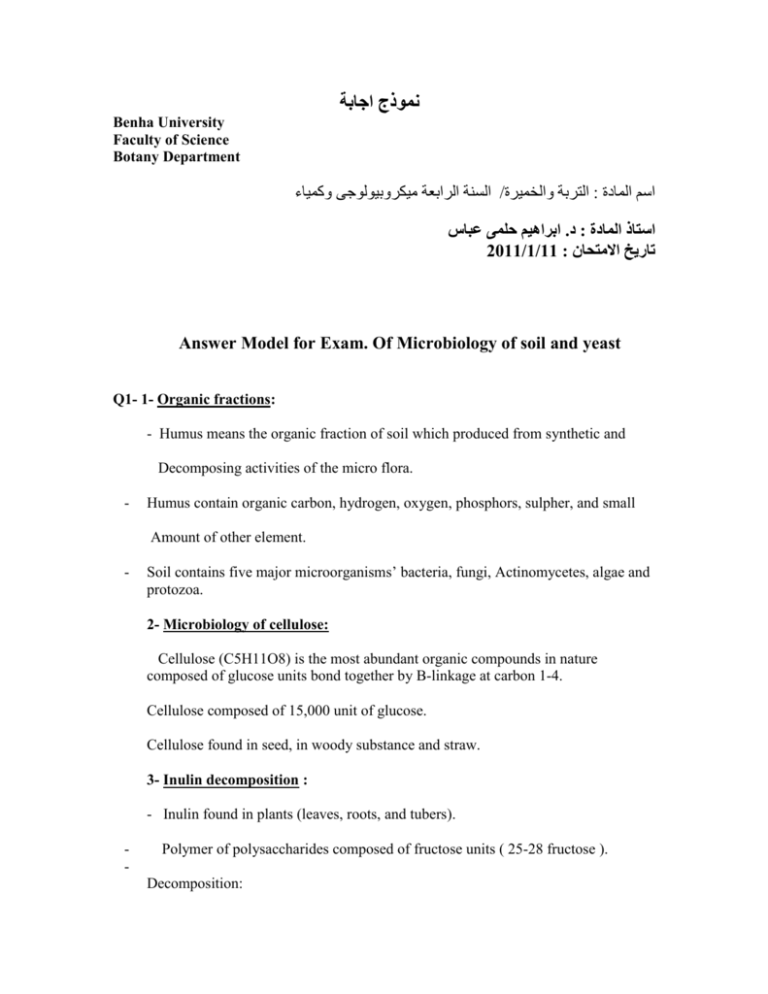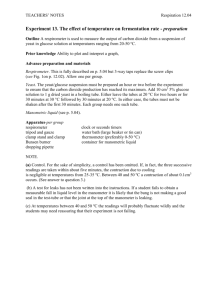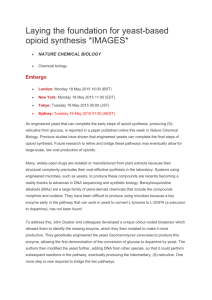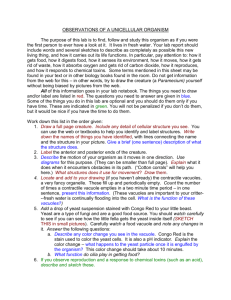Answer Model for Exam
advertisement

نموذج اجابة Benha University Faculty of Science Botany Department السنة الرابعة ميكروبيولوجى وكمياء/ التربة والخميرة: اسم المادة ابراهيم حلمى عباس. د: استاذ المادة 2111/1/11 : تاريخ االمتحان Answer Model for Exam. Of Microbiology of soil and yeast Q1- 1- Organic fractions: - Humus means the organic fraction of soil which produced from synthetic and Decomposing activities of the micro flora. - Humus contain organic carbon, hydrogen, oxygen, phosphors, sulpher, and small Amount of other element. - Soil contains five major microorganisms’ bacteria, fungi, Actinomycetes, algae and protozoa. 2- Microbiology of cellulose: Cellulose (C5H11O8) is the most abundant organic compounds in nature composed of glucose units bond together by B-linkage at carbon 1-4. Cellulose composed of 15,000 unit of glucose. Cellulose found in seed, in woody substance and straw. 3- Inulin decomposition : - Inulin found in plants (leaves, roots, and tubers). - Polymer of polysaccharides composed of fructose units ( 25-28 fructose ). Decomposition: Inulin ---- (by) inulinase enzymes Exoinulinase: Fractosan ( 2 unit) ------------ Fructose By Fractosanase ---------- Fructose Q2- Starch is polysaccharide, distributed bin xylem ,phloem, cortex, and pith of Stems (Tuber, bulbs, and corm). Chemistry : - Plant starch contain:- Amy lose and amylopectin. Glucose units attached with others glucose by 1-4 glucosidic bonds. Amylose linear polymer of glucose molecules by 1-4 glucosidic bonds water soluble. Amylopectin also is branched of glucose molecules joined by ~ 1-4 glucosidic bonds and ~ 1-6 bonds. Starch is an excellent carbon source for Actinomycetes, fungi, and yeasts. 1- ~-amylase 2- B-amylase 3- glucose amylase Amylopectin By ~ amylase, B- amylase Produce: branched oligosaccharides _________ by debranching enzymes Produce: linear oligosaccharides --------- by ~- glucosidase Produce glucose. Amylase ---------- By ~ amylase --------- Maltotiose ----- by ~ - gulcosidase Produce glucose. 2- Types of pectic substance : 1- Protopectin: water-soluble – found in cell wall. 2- Pectin: water soluble polymer of galactouronic acid that contain much methyl ester linkage. 3- Pectinic acid: colloidal pectic substance that are galactouronic acid polymer but contain methyl ester linkage. 4- Pectic acid: water soluble galacturonic acid – polymer that are devoid of methyl ester. 3- Decomposition of chitin: Break down of chitin is the conversion of an insoluble to soluble that penetrate The cells and serve to provide energy , carbon and nitrogen for growth. Enzymes responsible for transformation : 1- Chitinase: which Chitin converted by chitinase enzyme to chitobiose. 2- Chitobiose: which chitobiose converted to yield of N-acetyl gulucosoamine. 3- Chitosanases: which chitosan converted by enzyme to acetic acid + glucosoamine and ammonia. 4- Chemistry of formation of methane: CO2 + H2 ----------------- CH4 + H2O HCOOH -------------------- CH4 + CO2 + H2O CH3COOH ------------------ CH4 + CO2 CH3CH2OH ------------------ CH4 + CO2 Carbon cycle: - Carbon is the most important elements. - All living organisms are made up of molecules that contain carbon, carbohydrates, Protein and fats. - The carbon cycle includes all the reactions that allow living organisms to use Carbon to manufacture their tissues and release energy. - Plants are the starting points of the carbon cycle through the process of - photosynthesis – plant absorb carbon from air as CO2 and incorporated it into the biomass (leaves, wood, roots, flowers and fruits). - Thesis organic matter provides food for heterotrophic organisms by releasing - energy when they respire heterotrophic and autotrophic return carbon to the - atmosphere CO2. Q3: Fermentation : Alcoholic fermentation id the conversion of sugar into carbon dioxide and ethyl Alcohol. = The process is carried out by yeast enzymes. = This a complex series of conversation that bring out the conversion of sugar to CO2 and alcohol. = Cells gain energy from the break down of sugar. The fermentation process has other limits such as temperature create than 27C kill the yeast. Less than 5 C result in yeast activity which is too slow. Fermentation is in two parts : Part 1: Aerobic ( oxygen is present ): This is the initial repaid process where the yeast Is doubling its colony size every 4 hors (usually 24-28 hours ). Part II : Anaerobic : ( No oxygen ): Slower activity and the yeast focuses on the Conversion of sugar to alcohol rather that increase the number of yeast cells this process can take from days to week. 2- Cultural Characteristics :A- On liquid media : The growth are pellicle when cultivated on malt extract glucose and extract broth. B- On solid Media: The growth are mucoid (lipomyces). Some sp. Produce Pigments (Rhodotrolla). 3- Sexual Reproduction : May yeast form asci, which contain up to eight haploid ascospores. This ascospore may puse with adjoing nuclei and multiply through Vegetative division or as with certain yeasts Fuse with other ascospores. Q4 : Factors affecting growth of yeast : 1- Oxygen; yeasts are facultative anaerobic 2- Dedication : 3- Light : U.V light destroy yeast cell in short times 7 min. If yeast cell expose one hour this cause destroy the yeast. 4- Temperature: some yeast able to grow at 0C and some able to grow at 5C, but the optimum at 20-25C and The maximum At 30-40C 5- Cold tolerance : Some yeasts isolated from cold nature and 5C as psychrophilic facultative psychrophilic , the optimum at 15C. 2- What are yeast : Yeast are unicellular fungi, the classification is a field that uses the characteristics of The cell , ascospor and colony One of the more well known characteristics is the ability to ferment sugars for Production of ethanol Budding yeast are true fungi of the phylum Ascomycetes. The true yeast are separated into one main order Saccharomycetes. Yeast are also found in Skin surface Common yeast infection is typically Candidacies’ caused by yeast like fungi Candida is also a cause oliaperrash and thrush of the mouth and throats. Yeasts multiply as single cell that divided by budding or direct division ( fission e.g. Schizosccharomyces or they may grow as simple irregular filaments . 3- Reproduction of yeast : Asexual reproduction : Budding and formation ofarthrospores and conidia are the usual methods of asexual reproduction in saccharomycetales. In saccharomyces budding is initiated at the time of duplication of the spindle pole body. An area of the enzymatic wall softening within a newly developed chitinous ring allows a portion of the cell content surrounded by newly synthesized wall to push out through the contacting ring At the time nuclear division is almost complete , an abscission plate begins to form . This plates consists of a thin layer of chitin secreted at the invalidated plasma membrane of the separating Separation of bud from the mother cell then take place and a bud is evident on the mother cell opposite to the birth scar of the daughter . Sexual Reproduction : After plasmogamy is complete to produce the Zygote cell Kano gamy typically Occur in this cell which usually is the young ascus. In cephaoascus and a few others genera an ascoprogenisis occur there is no dikanytic phase in yeast. -






